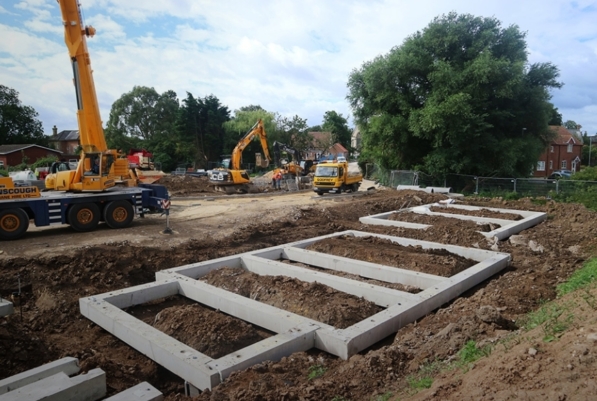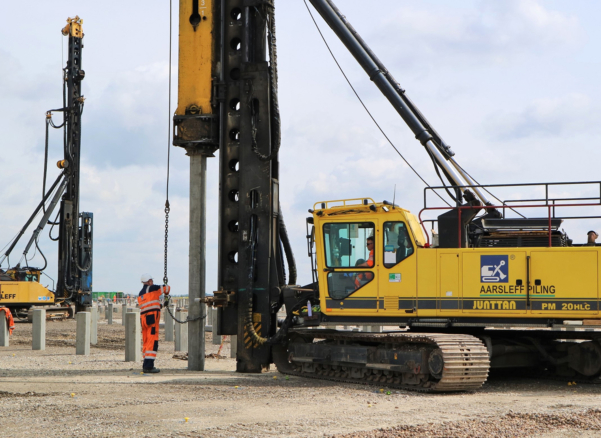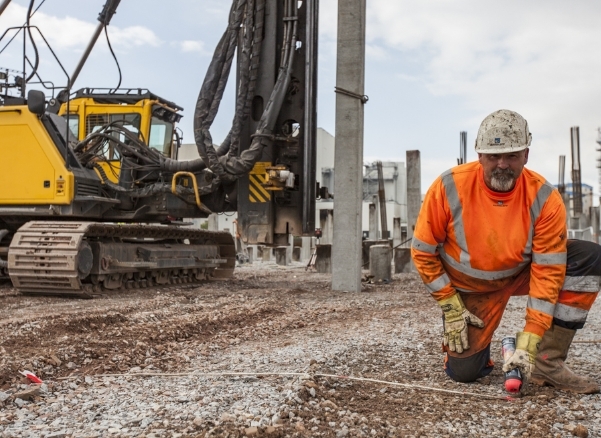Table of Contents
- What is Augered Piling?
- Continuous Flight Auger vs Sectional Flight Auger
- Where is Augered Piling Used?
- The Augered Piling Process
- What are Augered Piles Made From?
- Soil Types for Augered Piling
- Advantages of Augered Piling
- Augered Piling Across the UK
What is Augered Piling?
Augered piling is a deep foundation technique that creates cast-in-place piles using a rotating drill, commonly referred to as an auger. Unlike driven piling, which involves pummelling pre-formed piles into the ground, augered piling removes soil while drilling to the required depth. Once the hole is bored, it is immediately filled with a specially designed concrete mix. While the concrete is wet, a steel reinforcement cage is inserted into the centre of the bored hole.
In this process, the concrete provides the compressive strength needed to carry the structure’s weight, while the steel reinforcement adds further robustness and helps the pile to resist cracking or bending under load. They work in unison to form a solid foundation that can be tailored to the exact project needs.
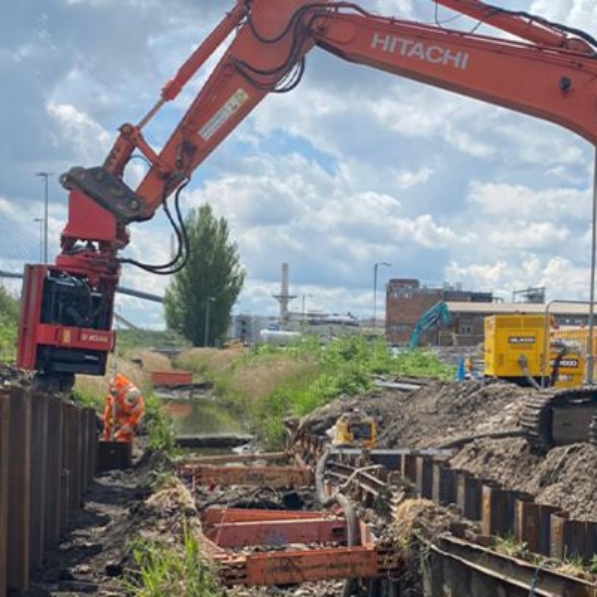
Continuous Flight Auger vs Sectional Flight Auger
Augered piling is carried out using two main types of equipment, each with its own benefits and individual strengths.
The Continuous Flight Auger (CFA) method employs a single continuous spiral, or flight, attached to a hollow stem. This auger is drilled into the soil to the desired depth in a single, uninterrupted movement. As the auger is withdrawn, concrete is pumped through the stem. CFA piling is efficient and quick, making it ideal for open sites with space for larger rigs. It is often used for medium to large projects, such as multi-storey buildings.
The Sectional Flight Auger (SFA) method uses an auger with shorter sections that can be added or removed during drilling, unlike the continuous spiral of the Continuous Flight Auger (CFA). This allows SFA piling in restricted spaces like tunnels or existing buildings. The concrete placement process is similar, but sometimes the auger may be withdrawn fully before pouring. While SFA is slower than CFA, it offers a solution in locations where rigs are unable to operate.
Where is Augered Piling Used?
Extremely versatile and adaptable for both large open spaces and tight, complex environments, augered piling is a key choice for foundational work across a wide range of sectors and environments. Examples include:
- Urban developments – Augered piling is useful in city-centre projects where low noise and low vibration are essential to protect nearby structures and services.
- Infrastructure projects – This method of piling is commonly used in bridges, retaining walls and in rail and road projects where ground conditions vary.
- Residential projects – Augered piles offer durable foundations without excessive disruption, whether you’re building large estates or single homes.
- Commercial buildings – Warehouses, retail parks and more utilise augers as foundation design can be tailored to the load capacity.
- Marine works – Auger screws can create foundations in marine and waterfront works when soils are suitable.
- Remedial works – This method can be used to help strengthen existing foundations or stabilise work done on slopes.
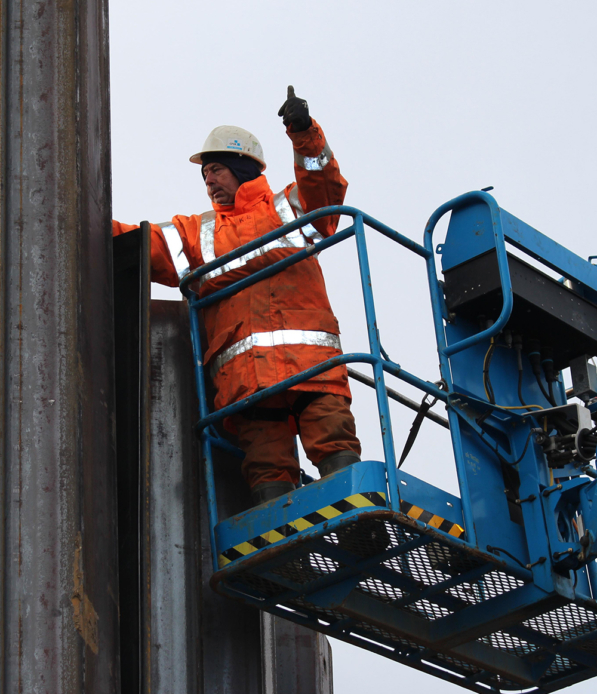
The Augered Piling Process
After thorough planning and design, engineers assess ground conditions and depth specifications to ensure the augered piles meet the structural demands of the project. Once this stage is finalised, the CFA or SFA is rotated into the ground.
The spiral flights in the auger cut into the soil, bringing excavated material to the surface. This process continues until the auger reaches its target depth, at which point concrete is poured in. The method used can slightly alter the pouring process, with the concrete either pumped through a hollow stem as the auger is withdrawn or into the bored hole immediately after the auger is removed.
While the concrete is wet, steel reinforcement is added to the centre of the pile to enhance its strength. Once the concrete has cured to the required stability, the pile is integrated into the wider foundation system. Throughout the process, the volume and pressure of the concrete are monitored, along with the torque and depth of the pile, to ensure the project meets safety and quality standards.
What are Augered Piles Made From?
Augered piles are typically constructed using specially formulated concrete mixes that provide strength and durability. These mixes may also include additives to improve the workability or durability of the concrete.
Cages or single steel reinforcement bars are also often utilised to provide tensile strength and help to counter the possibility of bending under high load capacity. As auger piles are formed on-site, they can be customised for depth, diameter and the level of reinforcement needed, making them suitable for a range of capacities and soil conditions.
At times, additional coatings or safeguards can be put in place as a preventative measure against corrosion or challenging environments.
Soil Types for Augered Piling
Augered piling is an effective method for working across various soil types, provided that the bore remains stable during drilling and concrete placement. Examples include:
- Clays and silts – Flight augers provide good stability during the drilling process in clays and silts.
- Mixed soils – Variable materials can be managed with CFA or SFA systems, so alternating layers of sand, gravel and clay are less of a problem.
- Loose sands and gravels – Augered piling works in these materials; however, they may require temporary casing to prevent collapse before concrete placement.
- Made ground – Artificial or modified ground can be penetrated to reach stronger layers below.
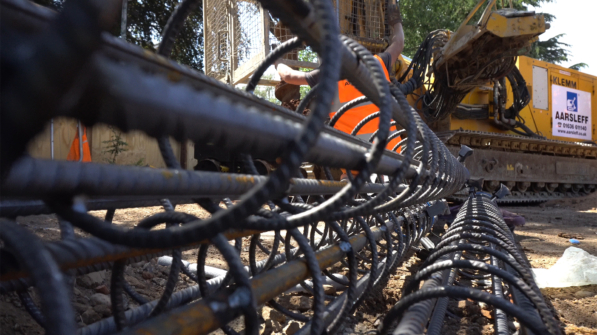
Advantages of Augered Piling
Augered piling offers several advantages when compared to other piling methods, making continuous flight auger piles and SFA methods a reliable choice across a range of projects and sectors.
- Installation is more precise, with auger screws allowing exact depth and diameter control.
- Useful dual flexibility across CFA and SFA in open sites and confined areas.
- Reduced noise and vibration to minimise disruption in built-up areas.
- Custom design tailored to load requirements and site conditions
- Enhanced versatility across a range of soil types thanks to available adaptations.
- Minimal soil disposal is required as it is lifted cleanly to the surface during the process.
Augered Piling Across the UK
At Aarsleff, we’re able to deliver augered piling solutions across the United Kingdom, providing expert advice and a choice of systems across CFA and SFA piling. We work across multiple sectors, including commercial and residential projects.
Whether requirements need low-vibration installation or precision for sites with restricted access, we adapt our approach to meet the needs of the project at hand. We continually review and refine our methods to reduce our environmental impact and ensure sustainability is at the heart of every development.
Need help with an ongoing project or looking for a quote for future works? Get in touch with us today to discuss our augered piling solutions.
